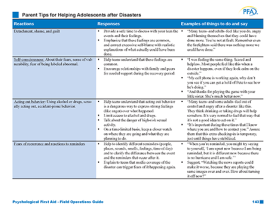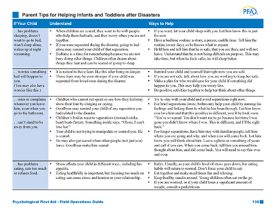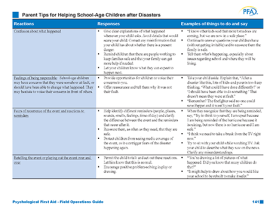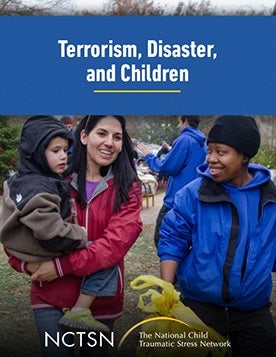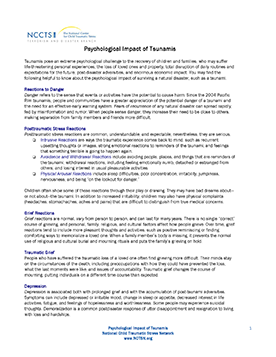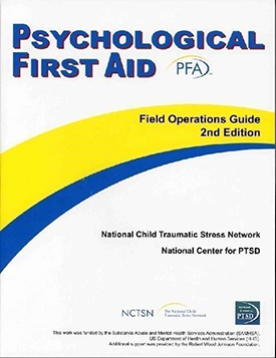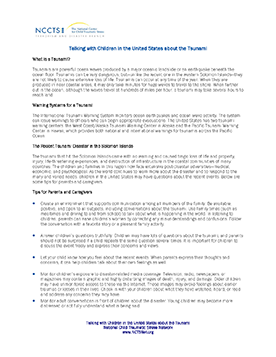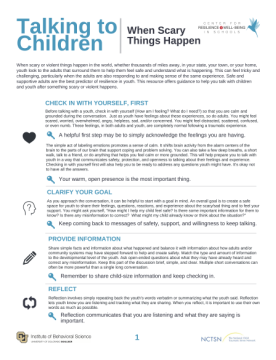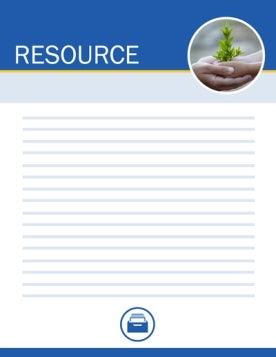A tsunami is a series of large powerful waves that come from the underwater movement that occurs naturally with earthquakes, volcanic eruptions, landslides, or meteorites. Tsunamis can occur at any time of the year, day or night, but they are not very common (occurring approximately once per year). The waves can travel fast—up to 500 mph. Distant tsunamis, generated by far-off underwater movement, won’t reach the coast for several hours and allow time for formal warnings. Local tsunamis, however, are generated by a strong, near-offshore underwater movement (usually an earthquake) and reach the coast minutes after the ground stops shaking and with little warning. Tsunamis can cause massive loss of life or injury and significant destruction to property and infrastructure. While it is possible that a tsunami could strike anywhere along the entire coastline of the U.S., the most damaging tsunamis have hit the coasts of American Samoa, Hawaii, Alaska, Washington, Oregon, and California.
Being prepared beforehand is the best way to help children and family members recover after a tsunami. Communities at risk for tsunamis should take an active role in encouraging their residents to be ready. The National Weather Service has two warning centers (Pacific Tsunami Warning Center in Hawaii and West Coast and Alaska Tsunami Center in Alaska). The officials at these warning centers can alert emergency managers in coastal communities of the potential of a distant tsunami. To improve preparedness, families should:
- Be informed about their tsunami risk. Have families identify if they are in a potential tsunami zone and the history of tsunamis in their area. They should also know how many feet above sea level their street is and how far it is from the coast or other high-risk waters, as evacuation orders may be based on these numbers. Encourage families to check if their insurance would cover flooding caused by a tsunami.
- Know how to evacuate safely. Families should know tsunami evacuation routes for their area and evacuation protocols for work and schools. Teach families to always evacuate inland and to higher ground, ideally at least 100 feet above sea level or at least 1 mile inland (some experts say 2 miles). Families should avoid rivers and streams, into which tsunami water could funnel. When evacuating, individuals may need to leave their belongings in order to safely get away. Because the waves can continue for hours and can increase in size, individuals should stay in their evacuation location until emergency officials report the “all clear.” Encourage families to practice evacuating annually.
- Be able to recognize natural tsunami warning signs. Local tsunami waves can hit coastal areas within minutes and before official alert systems can be activated. Families in tsunami risk areas should learn the official alert systems as well as natural warning signs that a tsunami is imminent. The following are natural warning signs that one needs to evacuate the coast immediately: a strong earthquake near the ocean that knocks people off their feet or lasts over 20 seconds; a loud roar coming from the ocean; unusual disappearance or rise of water in the ocean or odd bubbling; and animals seen acting strangely including suddenly leaving, gathering in groups, or trying to get into places they normally won’t go.
- Know how to access updated official tsunami information. Help families identify which websites, social media platforms, radio/news stations or mobile alerts will provide up-to-date tsunami information. Families should be familiar with sirens used to issue public notice of impending tsunamis, and know the following terms for tsunami conditions:
- Tsunami Information Statement: Indicates an earthquake has occurred or a tsunami warning, advisory, or watch has been issued for another part of the ocean. Most information statements indicate there’s no threat of a destructive tsunami to that area and aim to prevent unnecessary evacuations.
- Tsunami Watch: Indicates a distant earthquake has occurred and a tsunami is possible later in the area. People should stay tuned for updates and be prepared to take action if necessary.
- Tsunami Advisory: Indicates a tsunami with potentially strong waves dangerous to those in or very near the water is expected or occurring. There may be flooding of beach and harbor areas, but significant impact isn’t expected. People should stay out of the water and away from beaches and waterways.
- Tsunami Warning: Indicates a tsunami was or may have been generated, which could cause damage. People in the warned area should evacuate inland to higher ground.
- Assemble an emergency go kit. Families should have access to enough water, food, and other emergency supplies for at least 3 days and medications for at least 7 days. It is also helpful to gather copies of important documents, a radio with batteries to get weather updates, and supplies for pets. Keep supplies in a large backpack, duffel bag, or easy to carry container in the event the family has to evacuate quickly. Children can also pack their own kits and include their favorite toys. For more information, review the family preparedness plan.
- Make a family communication plan. Families should have important contact information easily accessible and should know who they might evacuate or stay with in the event of an evacuation. Make sure babysitters are aware of this important information. To help develop their plan, families can fill out the preparedness wallet card and carry it with them.
- Plan for children’s needs. Families should give children factual information about tsunamis in simple terms. Make sure children know the natural warning signs of an impending tsunami if they spend time by the coast and where to evacuate. Encourage parents to include children in preparedness activities. The Help Kids Cope app provides parents with ideas of how to talk with children of different developmental levels.
Knowing what to do right before and during a tsunami can help families feel more in control and take steps to increase their safety. Consider the following:
When a tsunami watch or advisory is issued, families should:
- Get tsunami updates and evacuation alerts from radio, TV, or a mobile device. Families should follow all instructions from local officials.
- Review their emergency supplies and put their “go kit” by the door. Families can also prepare by making sure their mobile phones are fully charged.
- Keep other household members informed. Families should notify all members of the tsunami watch and be ready to move quickly if a tsunami warning is issued.
- Stay out of the water and away from beaches, harbors, and waterways.
When residing near the coast or when a tsunami warning is issued, families should:
- Evacuate their house immediately. Families with their pets should quickly follow all evacuation orders and move to a safe, higher location. They should also evacuate if they observe one of the natural warning signs of a tsunami, including: an earthquake near the ocean that lasts at least 20 seconds or knocks people off their feet; an unusual disappearance or rise of water in the ocean; an odd bubbling in the ocean; a roaring sound coming from the ocean; or animals seen acting strangely by suddenly leaving, gathering in groups, or trying to get into places they normally won’t go.
- Evacuate by foot. It is best to walk or run inland to high ground and not evacuate by car as families could become trapped, stuck in traffic, or blocked by damaged roads.
- Bring only what’s necessary. Families should take their “go kit” if it is nearby, otherwise they need to leave all their belongings behind. They can take their pets with them if feasible.
- Take other precautions if unable to reach high ground. To be safer, families can move to an upper story of a sturdy building or a roof, climb up a tree, or grab a floating object and hang on until help arrives.
- Assist others in need. Encourage families to assist neighbors with special needs, including infants, small children, frail older adults, and individuals with functional or access needs.
- Stay evacuated until officials give the all clear. Tsunamis are a series of waves that can last several hours, so no one should return until official notice has been given.
To address children’s reactions during a tsunami, parents and caregivers can:
- Model calm behavior. Children may mirror the reactions of adults around them and will learn ideas for how to take care of themselves from what parents and caregivers do.
- Provide simple but accurate information in a quiet, steady voice. Depending on the urgency of the situation, addressing children’s questions may have to occur after the family gets to their safe location.
- Encourage comforting or distracting activities. Children may benefit from doing slow breathing to calm their bodies. Because families may need to stay evacuated for several hours, engage children in simple activities to keep them distracted. For additional ideas, go here.
- Practice their own self-care. Parents and caregivers may benefit from finding opportunities to take a moment for themselves, express their feelings, acknowledge that it is a scary situation, and engage in a coping strategy.
Tsunamis can occur with very little warning, which can heighten the fear and intensity of experiencing one and can also lead to greater loss of life and injuries. Tsunamis can pose an extreme psychological challenge to the recovery of children and families, who may have suffered life-threatening personal experiences, the loss of loved ones and property, total disruption of daily routines and expectations for the future, post-disaster adversities, and enormous economic impact.
Children will react differently to tsunamis depending on their age, developmental level, and prior experiences. Some typical reactions children may exhibit after a tsunami include the following:
- Fear of recurrence and a heightened sense of danger. This fear leads to children having separation anxiety and not wanting to be away from their loved ones and friends.
- Extreme sadness and anger for the numerous losses they experienced and missing those who were killed.
- Post-traumatic stress reactions including reactivity to reminders (e.g., hearing the sirens being tested, seeing large waves, an aftershock), being constantly “on the lookout” for danger, increased startle, or avoidance of people or places connected to the event.
- Disruptions in daily functioning, including changes in sleep, diet, the ability to concentrate, and withdrawal from pleasant activities.
- Increased physical complaints, including headaches, stomach aches, and general pain.
- Increased negative thoughts, such as thinking that the world is a dangerous place or that another tsunami may occur.
After a tsunami, most families will recover over time, particularly with the support of family, friends, and organizations. Children’s functioning and recovery will be influenced by how their parents and caregivers cope after the tsunami. Children often turn to adults for information, comfort, and help. To assist children, parents and caregivers can model being calm, using effective problem-solving to handle stressful situations, and using positive coping to respond to tsunami reminders. Parents and caregivers can also help children return to a consistent routine that provides opportunities for the family to spend time together, as children may need additional attention and comfort. Parents and caregivers should be honest when answering questions about the tsunami and its aftermath and provide information at a developmentally appropriate level. Parents and caregivers should also monitor themselves and their children for reactions that worsen or persist more than six weeks after the tsunami and seek additional help.
Below are resources to support children, families, and communities recover after a tsunami.
